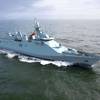Investigators said a bizarre combination of factors, including possible human error, had sunk an Italian chemicals tanker off France on October 31. The 7,300-ton Ievoli Sun, carrying 6,000 tons of toxic chemicals, went down in rough seas in the Channel 30 km (17 miles) from France's northerly Cotentin peninsula and close to the small British island of Alderney. It was the second large tanker to sink off France in a year and sparked accusations that owners were compromising safety.
However, a preliminary report by the maritime arm of the French Accident Investigation Bureau (BEA) gave the Italian owners Marnavi an initial clean bill of health. It said the 114-m (376-ft.) tanker had had around 60 safety inspections during its 11-year life, and had a sound structure and an experienced, well-qualified crew. Instead, investigators pointed to a combination of bad weather, design flaws and short circuits.
"In my 40 year career I have never seen an accident like this," said Jean-Louis Guibert, director general of maritime affairs at the BEA. The ship left the British port of Fawley on October 28 in stormy weather bound for the Yugoslav port of Bar. Some 24 hours later an alarm warned that water had entered the bow section. After checks, the captain decided that a small amount of water had poured in via the anchor chain shaft, but saw no imminent risk and sailed on.
Twelve hours later, the ship began laboring in the heavy seas and the crew realized that hundreds of tons of water had poured into forward ballast holds. Unable to control the ship, the crew were airlifted to safety.
French tugs tried to tow the stricken tanker to port, but the following day, before reaching land, it sank. Much of the cargo remains trapped on the seabed, 70 m (230 ft.) down. The BEA agreed that the water might have come in down the chain shaft, noting that this had happened on other ships, but it also said that the sea might have poured through a deck hatch which underwater footage of the wreck had shown to be wide open. BEA officials said the crew might have failed to close the hatch properly, but it might also have burst open after sinking.
"The real mystery is why the water then spread to the ship's holds," Guibert told a news conference. He said water might have come in from deck air vents, but that more research was needed. At one point water was gushing into the holds at the rate of 750 tons per hour, pushing the deck under the waves.
The crew tried to pump it out, but the pumps failed, probably because of a short-circuit in the flooded bow section. The BEA made no firm recommendations, saying only that maritime authorities should "pay special attention" to other such tankers, particularly to the chain shafts. Guibert said the shaft on the Ievoli Sun was normally blocked by a makeshift lump of concrete, but added that on a recent trip to the port of Rotterdam he had noticed that other chemical tankers had developed a more secure cap.
The full BEA report should be ready within a year. - (Reuters)
Sponsored Content
Innovative Hull Maintenance: Profitable & Green

Subscribe for
Maritime Reporter E-News
Maritime Reporter E-News is the maritime industry's largest circulation and most authoritative ENews Service, delivered to your Email five times per week











